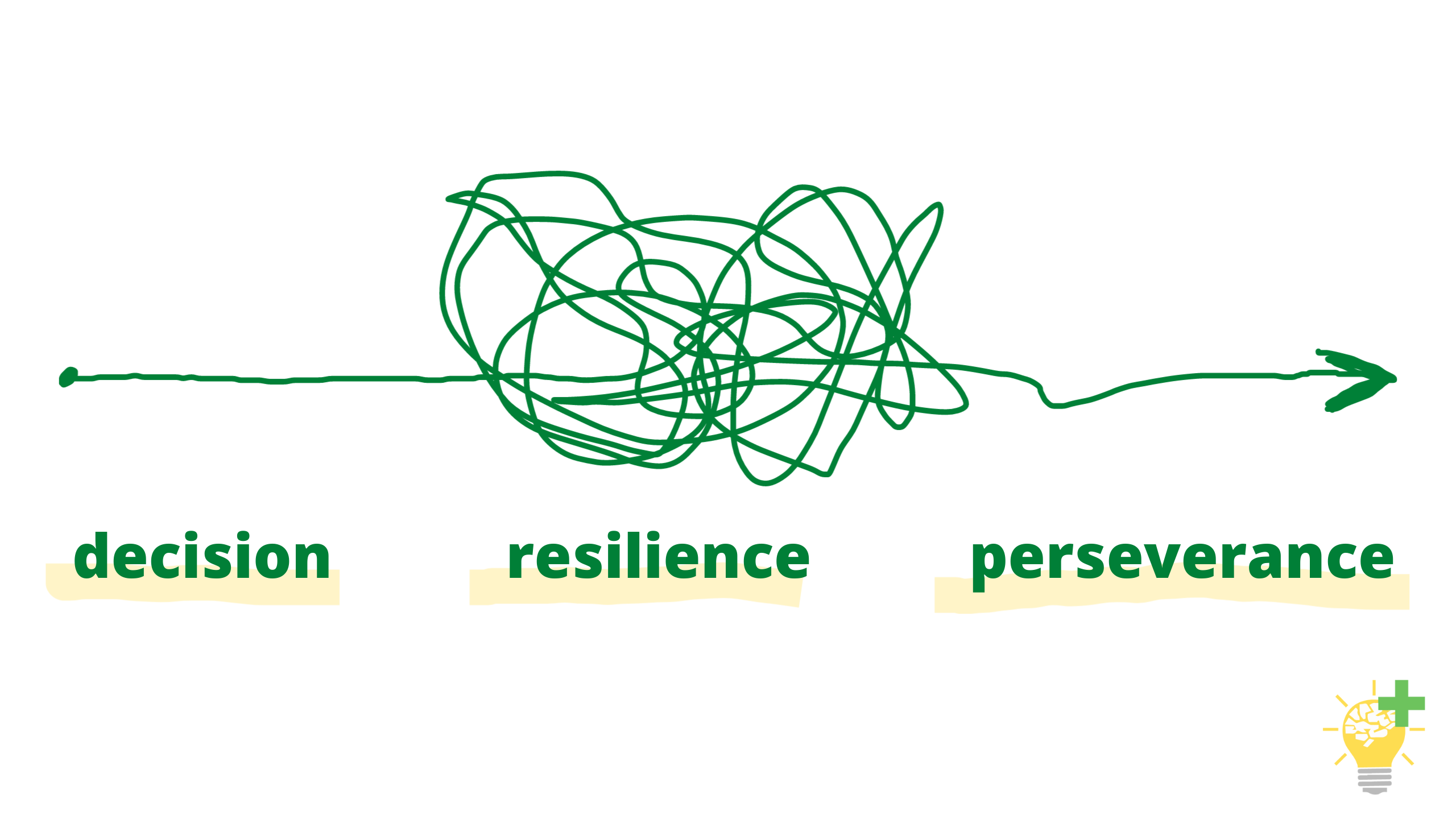The difference between resilience and perseverance is that resilience is a trait, while perseverance is an action. Resilience as a trait is something you may or may not have, but anyone can develop it over time through consistent effort. Perseverance as an action is something you do to achieve your goals. It requires hard work and dedication.
I have been blessed with the opportunity to know some amazingly resilient people throughout my life. I had a professor who was diagnosed with stage 4 pancreatic cancer. He was optimistic and cheerful when I visited him, even though he knew his prognosis was grim. After only a few short weeks, he passed away but not once did I see him get angry or bitter.
I have tried to develop such resilience in my life, especially during challenges.
Have you ever wondered why some people seem to bounce back from adversity while others don’t? Why does one person get knocked down and pick themselves up while another falls flat on their face and never gets back up?
What Is The Difference Between Resilience and Perseverance?
Resilience refers to our ability to recover or adapt after experiencing adverse events. Resilient people tend to bounce back better than those who aren’t.
Perseverance means to keep going even when encountering setbacks. People who persevere often achieve success because they refuse to give up.

How To Grow Our Resilience Trait
We live in an age where we’re bombarded by so much bad news from every direction that even if we don’t watch television at night, we hear about things like wars and natural disasters happening all around us.
Of course, this pandemic we are enduring has taken its toll on everyone’s mental health. We’ve seen friends lose loved ones, businesses go bankrupt, and entire industries shut down. In addition to all these external factors, there’s also the internal pressure of living in this world.
This can lead us to the importance of developing resilience and exercising perseverance to keep moving forward with positivity and goals.
How’s Your Mindset
Do you believe intelligence, talents, and other qualities are innate and unchangeable when you pursue a goal? The fixed mindset believes that you will probably never improve if you suck at something now; why try. A person with a growth mindset believes that your intelligence can improve through diligent study and talents improve from continual practice.
Your mindset has an enormous impact on your motivation, resilience, success, and achievements.
People who possess a growth mindset tend to see effort, learning, adapting, and perseverance as integral parts of the process. Those with a fixed mindset, on the other hand, think their abilities are limited and tend to become disheartened when faced with challenges. They may even decide not to take action at all.
The Growth Mindset Explained (video)
Resiliency: skills of recovering from setbacks. It means having flexibility, staying calm, and looking for solutions rather than focusing on the problem itself. That’s what it takes to get back up after a particular challenge or several difficulties.
Resilience means “adapting well” when faced with challenges, tragedies, traumas, threats, or significant risks. It doesn’t mean just avoiding one bad thing; instead, it means managing and adapting to ongoing stresses and disappointments and holding up well under pressure.
Resilience is an acquired skill, one which we develop through experience. To build that muscle, we need to lift ourselves off the ground without any help from anyone else. In practice, we cannot be resilient at all times. Only when things get confusing and anxious do we develop our resilience.
To adapt to a new normal, you need to learn from past experiences not to repeat them. When things get tough, we often discover just how strong we are. A key trait associated with resilience is believing that we control our outcomes through our efforts rather than chance.
Throughout history and all around us, people now demonstrate their resilience by bouncing back from whatever life throws at them. It’s an innate trait of who we are. We humans are so good at adapting to adversity that we often thrive when things get tough.
“Although the world is full of suffering, it is also full of the overcoming of it.”
― Helen Keller
Improving The Action of Perseverance
For someone to be successful, they need the perseverance to get the results they desire. A successful person must persevere through obstacles and setbacks. Willpower alone won’t be enough. People who believe they aren’t good enough for something don’t even attempt it because they fear failure.
People who are persistent through adversity tend not to be affected by their environment.
Persistence is simply continuing forward even when there’s resistance. Because resistance is a guarantee, it comes from everything around us; the world can always find something they don’t like. Sometimes it will come from within because you don’t know where to start, what to do next, fear of the unknown, doubting yourself, or things don’t go according to plan.
Repeated efforts lead to success. Sometimes those efforts need to be done when the wind and spit and dust are blowing into your face and eyes – make sure you’re wearing your mask and goggles.
You might find yourself doing things differently than you expected. It’ll possibly take longer than you anticipated. Sometimes there will be periods when there’s almost no forward motion at all. The rule is simple but not always easy to follow: Keep going – never give up.
Adapting involves flexibility; rebounding requires optimism; seeing past the current situation means having a positive attitude.
It’s not about either intelligence or resources; rather, the power in resilience, perseverance, and the willingness to wait for things that come from within us. It’s available to anyone who wants it, but it takes both patience and sheer determination to get there.
The Nitty Gritty Of Building Resilience/Perseverance?
Are you interested in becoming a resilient person? Or learning strategies for parents to build the resilience of children you have or hope to have? Well, let’s get after then.
I want to emphasize the importance of this being one of your long-term goals. This isn’t professional advice; it’s just my piece of advice on a complex undertaking. When it comes to perseverance to resilience, it’s vital to think positively and have peace and joy in this life.
5 Steps to Become a Resilient Person
We all face our own unique set of difficult circumstances. Some of you have exercised your resilience muscles more than others, but these steps are a foundation for resilience.
1. Build Strong Relationships
We can all identify critical people in our lives. But when building relationships, we have to know who the right people are to make a relationship.
I recently heard a woman talk about how she had a terrible stepmother. She related her life as a real-life Cinderella and it took years for her to realize that it was not requisite for her to keep that relationship.
One of the most important relationships I have is with God. Of course, not everyone has God as an emphasis in their life. So, one relationship that I feel is universal is the relationship with yourself. It would be best if you were kind and accepting of who you are. You are amazing!
Beyond having a positive relationship with yourself, you should surround yourself with compassionate and empathetic people. It is good to have a support group, even if only one or two correct key people.
Building strong relationships is our first foundation for resilience.
2. Take Care of Your Mind and Body
Wellness in self-care isn’t just a trendy fad; it is essential to maintaining good physical and mental health and building resiliency. Positive lifestyle choices like good nutrition, proper exercise, plenty of water, and adequate rest can help keep your body and mind ready for whatever happens in life.
Practice mindfulness through journaling, prayer or meditation, or yoga and breathing exercises. These simple practices can help you be prepared to cope with difficult situations. It can help you develop more gratitude. And gratitude has a significant impact on your resilience.
Avoid negative outlets that can be self-destructive, like negative self-talk, drugs, or alcohol. These substances can mask pain, but they will never solve your problems.
That’s your healthy dose, step number two to building your resilience muscles!
3. Watch Your Stress
Stress is something that every human experiences at some point in their life. However, stress doesn’t always mean bad things happen to us. Sometimes, stress is necessary to push us to grow.
When you experience stress, take time to reflect on what caused the stress. Was it a situation where you were forced into action? Or did you create the situation by taking on too much responsibility?
If you’re feeling stressed out, try to find ways to reduce the amount of pressure you put on yourself. Instead of doing everything yourself, ask someone else to help you. Yep, it goes back to those relationships.
There is a relationship between stress and resilience. When our stress levels are high, our resilience can wain. This is because the link between stress and our mental ability to bounce back from adversity decreases.
However, there is also an inverse relationship between stress and resilience. When we develop more resilience, we can better handle stress.
Identify signs of stress that are building in your life. Signs of stress are unique and can manifest both physically and emotionally. Some examples might include achiness or muscle tension or weakness, restlessness and even exhaustion, difficulty having sex, or having digestion problems. Emotionally you might experience anxiety, sadness, irritability, or become short-tempered with others.
If you can identify sources of stress in your life, you can better decrease or manage stress.
Create a stress-free environment where you can find renewed strength. This stress-free environment could be a comfortable environment like a park or an experience like reading a book or taking a walk. It is vital to address stress as soon as possible to prevent chronic stress from becoming the norm.
Occasional stress is a given; chronic stress is a tragedy.
4. Identify Purpose In Your Life
You might notice that I didn’t write a purpose or your purpose. I feel that far too often, good-intentioned authors and influencers speak of purpose as if it’s singular.
The reality is that we may have a purpose to fulfill, but it is far more important that we are engaged in good causes in our journey. We don’t need to know OUR PURPOSE to be a source of good. Just do something!
When we do something – a short-term goal or the successful completion of a task we become more resilient because we create a habit of achievement—even simple achievements matter.
5. Embrace Forgiveness
The final step of building resilience is all about forgiveness. This is a major piece because it becomes difficult to endure new challenges when we hang onto the difficulties we have endured. This can have a considerable impact on our daily life.
Besides forgiving, we need to accept forgiveness. The previous failure is something we all know, and it’s okay to let it go.
When we apply these simple steps to our life, we will become much more resilient to this, I’m sure. Besides these steps, we can do some other things when encouraging children to be resilient.
How to Build Resilience and Perseverance In Young Children
As adults, we have experienced foreign things to children, and it is essential to help foster specific traits. Indeed, some children have an adaptive mindset, but it seems to result from proper development than a natural occurrence.
Here are just a few strategies for parents:
Role Modeling
It’s important to show children how to face and overcome obstacles.
That’s why we have to develop resilience for ourselves. It is almost impossible to teach something we don’t already understand.
Natural Consequences
I don’t support letting a child touch a hot stove, but children need to learn natural consequences to develop resilience. How would a child improve if a parent did their homework for them?
Teach children about natural consequences by giving examples. Then when a failure occurs, as it always will, encourage.
Choose your words carefully when giving both encouragement and discipline to create false expectations – like perfectionism.
Acknowledge Emotions
Children need empathy more than they need a pep talk. As mentioned, encourage and let children know that it’s okay to have all emotions.
They need help to understand change. Children can experience any emotion as long as they know that they don’t need to stay in that emotion forever if it’s undesirable.
Problem-Solve Problem-Solving Skills
Problem-solving is perhaps the most important skill that I believe a child can learn at this current age. Resilience demands problem-solving.
The resilience of children is already inspiring, but for them to excel in life, they need critical problem-solving skills. Problem-solving not only includes their math ability; it consists of any problem that they may face. Help them develop an adaptive mindset.
So, rather than letting resilience become a challenge for children, we should help them develop resilience to overcome unfavorable circumstances whenever they happen.
Other Comparisons What’s the difference?
In writing this article on the topic of resilience and perseverance, I found a few other terms resilience shares some similarities.
What Is The Difference Between Fortitude vs Resilience?
According to wikidiff, the difference between fortitude and resilience is that fortitude is mental or emotional strength that enables courage in the face of adversity. In contrast, resilience is the mental ability to recover quickly from depression, illness, or misfortune. [source]
What Are Grit and Resilience?
Grit and resilience are two related terms often used interchangeably but are entirely different constructs in actuality. Grit is defined as perseverance and passion toward long-term goals and describes sustained commitment toward completing a specific endeavor despite episodes of failure, setbacks, and adversity.
[source]
Often, teachers, professors, and others who teach will say that intelligence isn’t the only thing separating good from bad students. As we increasingly see, the single most important factor for predicting success isn’t social intelligence, attractiveness, physical fitness, or even IQ.
It’s grit.
Grit is “living life like it’ s a marathon, not a race.” What exactly is “grit”? What else could we use to nurture it?
“Grit is passion and perseverance for very long-term goals,” according to American psychologist Angela Duckworth’s research. “Grit is having stamina,” she continues. “Grit is sticking with your future, day in, day out, not just for the week, not just for the month, but for years, and working hard to make that future a reality.”
Angela Duckworth’s research claims that grit is still very unclear. Here are five common examples of grit or characteristic rather. Based on these characteristics, how’s your level of grit?
1. Courage
Physical bravery isn’t the only kind of bravery. There are many different kinds of courage. Courage isn’t the lack of fear; instead, it’s the ability to overcome it.
Courageous people take chances when others won’t; follow their visions regardless of whether they’re popular or not. They stand up for what they believe in, even if it means risking rejection from friends and family; or doing the right thing, even if there are easier ways to get things done.
Courageous people possess these traits: they’re patient; they can believe the unbelievable; and don’t hesitate to say “No.” They’re not afraid to take an unpopular stance, ask for help, or be wrong. They’re able to forgive others’ mistakes and move on quickly, yet they remain steadfast when others abandon their efforts.
2. Conscientiousness
Being conscientious means doing things well and efficiently, not just completing tasks but finishing them properly too. Conscientious people tend to follow the rules and regulations; their views on anything are seldom taken lightly.
Conscientious people need to be careful in being too rigid, as they are usually perfectionists who want things done “right.”
Finally, the conscientious person works hard at his job and has concentrated, focused effort. They enjoy organizing things into neat piles and making lists. Conscientious people don’t change their minds easily; they’re determined to hold onto their beliefs no matter what others say.
3. Perseverance
“If you are going through hell, keep going,” Winston Churchill famously said. Indeed, for most people, perseverance means pain and suffering; however, those who genuinely persevere – see hardship not as an obstacle but rather as a gateway to joy.
Perseverance means starting something and continuing with it until you reach whatever goals you’ve set for yourself. It’s often the most critical factor when trying to achieve anything. One of the differences between people who succeed and people who spend too much time doing things without any real purpose is this: do something for a reason.
Long-term goals help keep you motivated throughout the year. Grit is an integral part of success because it provides the context and framework for finding the meaning and value of our long-term efforts.
4. Resilience
One word for resilience is toughness, the ability to bounce back after setbacks. Those who are excessively optimistic often display greater resilience than others. They approach life with an attitude of fun, self-awareness, and the ability to laugh at themselves and their situation.
Resilient people often have a strong sense of morality or belief system they won’t abandon. They don’t compare themselves to others but instead evaluate their achievements against their capacity. They believe they’re facing challenges because these situations present opportunities to grow into better people.
They don’t try to control their life. They cultivate self-awareness and mindfulness instead. They adapt to whatever situation they’re in by adjusting their attitude and setting new goals.
5. Passion
Passion without action leads to mediocrity. People who feel passionate about something tend to be driven by a strong desire for change. They’re usually selfless when they act. They’re self-aware; they understand who they are and what they stand for.
They see life as a series of opportunities for improvement and choice rather than a fixed outcome. Goals drive them, and they’re results-oriented. They never give up; they always keep trying until they succeed. They’re just as interested in the success of others as they are in their own. They’re responsible for themselves, yet don’t be afraid to ask for help when needed.
People who are passionate know that they control their own destiny!





Pingback: Understanding the Nuances in Personal Growth – Boomers
Pingback: Homepage
Pingback: nfl jerseys cheap
Pingback: มรกตโคลัมเบีย
Pingback: หวยลาว ออกอะไร ออกกี่รอบ ดูย้อนหลังได้ที่ไหน
Pingback: klik dultogel
Pingback: สล็อต เครดิตฟรี
Pingback: ใบพัดเครื่องจักรอุตสาหกรรม
Pingback: Bundle extractor
Pingback: wps官网
Pingback: poker online
Pingback: เสริมจมูก พัทยา
Pingback: 홀덤사이트
Pingback: Gun shop USA
Pingback: เรียนต่อจีน
Pingback: pg333
Pingback: ทำความรู้จัก Spadegaming ค่ายสล็อตอันดับ 1
Pingback: รับสร้างบ้าน
Pingback: torzon
Pingback: อาหารเสริม omg
Pingback: ไก่ตัน
Pingback: -
Pingback: towable pivot
Pingback: Bilskrot Bugatti
Pingback: Skrota en gammal Koenigsegg
Pingback: สล็อตค่าย pg เกมใหม่ๆ
Pingback: บับเบิ้ลกันกระแทก
Pingback: Jaxx Wallet
Pingback: ritalin kopen online betrouwbaar
Pingback: สำนักงานบัญชี ภูเก็ต
Pingback: dark168
Pingback: hit789
Pingback: oxynorm
Pingback: clonazépam
Pingback: psychotherapist long island
Pingback: รับจัดงานอีเว้นท์
Pingback: บาคาร่าเกาหลี
Pingback: เว็บตรง lucabet
Pingback: sa casino
Pingback: Darknet Market
Pingback: thailand tattoo
Pingback: Staten Island real estate